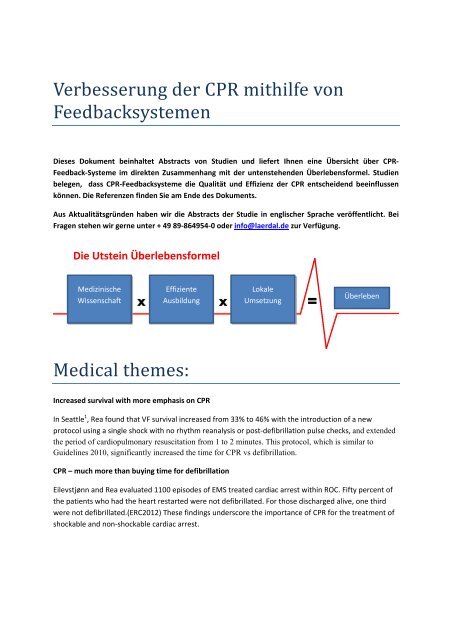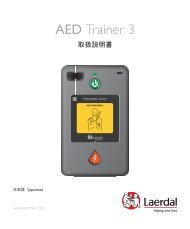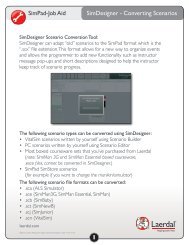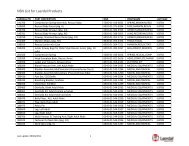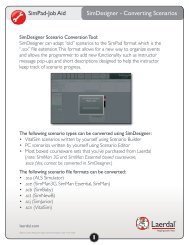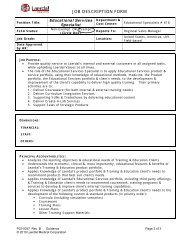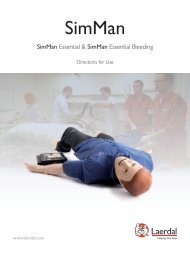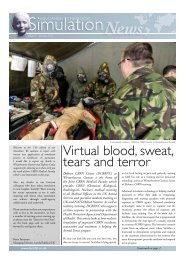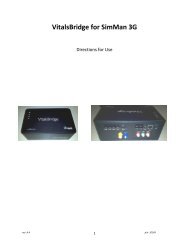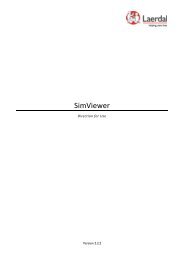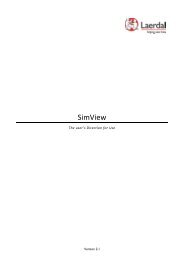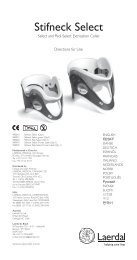Verbesserung der CPR mithilfe von ... - Laerdal Medical
Verbesserung der CPR mithilfe von ... - Laerdal Medical
Verbesserung der CPR mithilfe von ... - Laerdal Medical
Create successful ePaper yourself
Turn your PDF publications into a flip-book with our unique Google optimized e-Paper software.
<strong>Verbesserung</strong> <strong>der</strong> <strong>CPR</strong> <strong>mithilfe</strong> <strong>von</strong><br />
Feedbacksystemen<br />
Dieses Dokument beinhaltet Abstracts <strong>von</strong> Studien und liefert Ihnen eine Übersicht über <strong>CPR</strong>‐<br />
Feedback‐Systeme im direkten Zusammenhang mit <strong>der</strong> untenstehenden Überlebensformel. Studien<br />
belegen, dass <strong>CPR</strong>‐Feedbacksysteme die Qualität und Effizienz <strong>der</strong> <strong>CPR</strong> entscheidend beeinflussen<br />
können. Die Referenzen finden Sie am Ende des Dokuments.<br />
Aus Aktualitätsgründen haben wir die Abstracts <strong>der</strong> Studie in englischer Sprache veröffentlicht. Bei<br />
Fragen stehen wir gerne unter + 49 89‐864954‐0 o<strong>der</strong> info@laerdal.de zur Verfügung.<br />
Die Utstein Überlebensformel<br />
Medizinische<br />
Wissenschaft<br />
Effiziente<br />
Ausbildung<br />
Lokale<br />
Umsetzung<br />
Überleben<br />
<strong>Medical</strong> themes:<br />
Increased survival with more emphasis on <strong>CPR</strong><br />
In Seattle 1 , Rea found that VF survival increased from 33% to 46% with the introduction of a new<br />
protocol using a single shock with no rhythm reanalysis or post‐defibrillation pulse checks, and extended<br />
the period of cardiopulmonary resuscitation from 1 to 2 minutes. This protocol, which is similar to<br />
Guidelines 2010, significantly increased the time for <strong>CPR</strong> vs defibrillation.<br />
<strong>CPR</strong> – much more than buying time for defibrillation<br />
Eilevstjønn and Rea evaluated 1100 episodes of EMS treated cardiac arrest within ROC. Fifty percent of<br />
the patients who had the heart restarted were not defibrillated. For those discharged alive, one third<br />
were not defibrillated.(ERC2012) These findings un<strong>der</strong>score the importance of <strong>CPR</strong> for the treatment of<br />
shockable and non‐shockable cardiac arrest.
High chest compression fraction is an independent determinant of survival in VF cardiac arrest<br />
Christensen and coworkers from ROC analyzed 506 cases and found highest survival when chest<br />
compression fraction was between 61 and 80%.<br />
Chest compression fraction is important for non‐VF patients<br />
Vaillancourt 2 found a trend to increased ROSC with increasing chest compression fraction for non‐VF<br />
patients.<br />
Poor chest compressions does not circulate adrenaline<br />
EMS, trained to Guidelines 2000, used a chest compression depth of only 34mm and a chest<br />
compression fraction of only 50% according to Wik 3 . When this treatment was given to laboratory pigs,<br />
no hemodynamic effect of adrenaline could be detected<br />
Short chest compression pauses does not reduce blood pressure<br />
Contrary to the previous animal studies, this study in humans demonstrates that blood pressures achieved<br />
before the rhythm analysis pause do not necessarily decrease after the pause but may even increase if the<br />
duration of the pause is un<strong>der</strong> ten seconds and the quality of <strong>CPR</strong> is good both before and after the pause. 4<br />
Leaning is common and affect patient outcome<br />
Fried 5 found incomplete release in 91% of the patient cases and in 12% of all pediatric chest<br />
compressions. According to Zuercher 6 , leaning impairs both cardiac output and myocardial blood flow<br />
during cardiac arrest.<br />
The importance of chest compression depth<br />
Suboptimal compression depth was found in half of patients by 2005 guideline standards and almost all<br />
by 2010 standards as well as an inverse association between compression depth and rate. A strong<br />
association between survival outcomes and increased compression depth could be demonstrated, but<br />
no clear evidence to support or refute the 2010 recommendations of >50 mm 7 .<br />
Guidelines 2010 require doubling of compression force.<br />
In a study by Wik 3 , average compression depth without feedback was 34mm and applied force for<br />
34mm depth is about 25kg according to Nysaether 8 and Tomlinson 9 . With guidelines 2010, 50mm chest<br />
compression depth will require a force of at 50kg for the average patient.<br />
<strong>CPR</strong> Meter is safe<br />
Zuercher 10 found that devices like the <strong>CPR</strong> Meter do not impair hemodynamics during piglet <strong>CPR</strong>.<br />
<strong>CPR</strong> is safe for victims not in cardiac arrest<br />
ILCOR 11 state that serious complications among non‐arrest patients receiving dispatch‐assisted<br />
bystan<strong>der</strong> <strong>CPR</strong> occurred infrequently. Of 247 non‐arrest patients with complete follow‐up who received
chest compressions from a bystan<strong>der</strong>, 12% experienced discomfort; only 5 (2%) suffered a fracture; and<br />
no patients suffered visceral organ injury.<br />
Education themes:<br />
<strong>CPR</strong> feedback devices is recommended during training<br />
A review by Yeoung 12 provides good evidence supporting the use of <strong>CPR</strong> feedback/prompt devices<br />
during <strong>CPR</strong> training as a strategy to improve <strong>CPR</strong> skill acquisition and retention. The review include a<br />
VAM study by Wik 13 where subjects who received first 1 initial plus 5 short training sessions shortly<br />
thereafter performed better during skill retention testing than those who only received 1 initial training.<br />
Oermann 14 found that monthly training with a VAM feedback resulted in superior performance vs<br />
annual training. These studies supports our strategy of low dose, high frequency training.<br />
<strong>CPR</strong> feedback devices offer just in time training<br />
Another study by Wik 15 randomized participants to do 3 min <strong>CPR</strong> on a manikin, both with and without<br />
VAM feedback. The group who did <strong>CPR</strong> first with feedback performed better than the group without<br />
feedback. Interestlingly, the group who received feedback first continued to perform at least as good<br />
when feedback was turned off. This study supports our strategy that feedback can facilitate just in time<br />
training.<br />
Implementation themes:<br />
Decay in EMS chest compression quality due to fatigue is rare<br />
Half of the provi<strong>der</strong>s compressed the chest according to guidelines depth in this study of EMS prolonged<br />
resuscitation. Chest compression decay and thereby fatigue within the first two minutes was rare,<br />
suggesting that the paramedics were capable of performing good chest compressions but they did not<br />
know how hard to push 16 .<br />
Q<strong>CPR</strong> improved <strong>CPR</strong><br />
Real-time visual and audible feedback by MRx with Q<strong>CPR</strong> altered performance to more closely conform<br />
with guidelines. 17 . However, since there was little room for improvement in <strong>CPR</strong> quality by these EMS<br />
systems (Pittsburgh and Seattle), no improvement in patient outcomes could be detected.
Compression quality is better with <strong>CPR</strong> meter<br />
A study by Skorning 18 evaluated <strong>CPR</strong> Meter. Depth improved from 45% correct to 73% correct and rate<br />
improved from 64% to 95% correct. Leaning improved from 4.4% to 0.2%.<br />
Q<strong>CPR</strong> feedback improve leaning<br />
Niles 19 found that automated feedback helped reduce leaning from 50% to 27% of all chest<br />
compressions in a series of in‐hospital pediatric arrest.<br />
Compression quality is better with a combination of feedback and debriefing.<br />
The combination of feedback and debriefing improved compression rate compliance from 45% to 84%<br />
and resulted in a doubling of participants providing compressions of both adequate rate and depth,<br />
from 29% vs. 64% 20 .<br />
Patient outcome is better with a combination of feedback and debriefing.<br />
This study by Edelson 21 report an increase in ROSC, a decrease in ventilations per minute and an<br />
increase in chest compression depth when MRx with QXPR was complemented with debriefing.<br />
Feedback is also helpful in helicopter and moving ambulance<br />
Real time automated feedback improves certain aspects of <strong>CPR</strong> quality in flying helicopters and moving<br />
ambulance vehicles. The effect of feedback guidance was most pronounced for chest compression rate. 22<br />
Voice prompts in addition to audiovisual feedback did not add value.<br />
In this clinical trial 23 , compression depth and rate, as well as survival was good both with and without<br />
voice prompts in addition to visual feedback and a metronome.<br />
Q<strong>CPR</strong> require mattress compression<br />
When <strong>CPR</strong> is performed in a bed, mattress compression and hence accelerometer error is was 13mm.<br />
When a stretcher was used, the error was 4mm 24 . These data suggest that about 15mm must be added<br />
for <strong>CPR</strong> in a bed, according to Monsieurs 25 .<br />
RefShare<br />
All papers cited are available on RefShare – our library of medical science.<br />
To access, go to Knowledgelink, select tools and select Refshare. Here you can search using keywords.<br />
Helge Myklebust, August 2012
REFERENCES<br />
1. Rea TD, Helbock M, Perry S, et al. Increasing use of cardiopulmonary resuscitation during out‐ofhospital<br />
ventricular fibrillation arrest: survival implications of guideline changes. Circulation<br />
2006;114:2760‐5.<br />
2. Vaillancourt C, Everson‐Stewart S, Christenson J, et al. The impact of increased chest compression<br />
fraction on return of spontaneous circulation for out‐of‐hospital cardiac arrest patients not in ventricular<br />
fibrillation. Resuscitation 2011;82:1501‐7.<br />
3. Wik L, Kramer‐Johansen J, Myklebust H, et al. Quality of cardiopulmonary resuscitation during out‐ofhospital<br />
cardiac arrest. JAMA 2005;293:299‐304.<br />
4. Hoppu S, Sainio M, Huhtala H, Eilevstjonn J, Tenhunen J, Olkkola KT. Blood pressure during<br />
resuscitation in man‐The effect of pause during rhythm analysis revisited. Resuscitation 2011;82:1460‐3.<br />
5. Fried DA, Leary M, Smith DA, et al. The prevalence of chest compression leaning during in‐hospital<br />
cardiopulmonary resuscitation. Resuscitation 2011;82:1019‐24.<br />
6. Zuercher M, Hilwig RW, Ranger‐Moore J, et al. Leaning during chest compressions impairs cardiac<br />
output and left ventricular myocardial blood flow in piglet cardiac arrest. Crit Care Med 2010;38:1141‐6.<br />
7. Stiell IG, Brown SP, Christenson J, et al. What is the role of chest compression depth during out‐ofhospital<br />
cardiac arrest resuscitation?*. Crit Care Med 2012;40:1192‐8.<br />
8. Nysaether JB, Dorph E, Rafoss I, Steen PA. Manikins with human‐like chest properties‐‐a new tool for<br />
chest compression research. IEEE Trans Biomed Eng 2008;55:2643‐50.<br />
9. Tomlinson AE, Nysaether J, Kramer‐Johansen J, Steen PA, Dorph E. Compression force‐depth<br />
relationship during out‐of‐hospital cardiopulmonary resuscitation. Resuscitation 2007;72:364‐70.<br />
10. Zuercher M, Hilwig RW, Gura M, et al. A sternal accelerometer does not impair hemodynamics<br />
during piglet <strong>CPR</strong>. Resuscitation 2011.<br />
11. ILCOR. 2010 International Consensus on Cardiopulmonary Resuscitation and Emergency<br />
Cardiovascular Care Science With Treatment Recommendations. Resuscitation 2010;81:e1‐e330.<br />
12. Yeung J, Meeks R, Edelson D, Gao F, Soar J, Perkins GD. The use of <strong>CPR</strong> feedback/prompt devices<br />
during training and <strong>CPR</strong> performance: A systematic review. Resuscitation 2009;80:743‐51.<br />
13. Wik L, Myklebust H, Auestad BH, Steen PA. Retention of basic life support skills 6 months after<br />
training with an automated voice advisory manikin system without instructor involvement. Resuscitation<br />
2002;52:273‐9.<br />
14. Oermann MH, Kardong‐Edgren SE, Odom‐Maryon T. Effects of monthly practice on nursing students'<br />
<strong>CPR</strong> psychomotor skill performance. Resuscitation 2011;82:447‐53.
15. Wik L, Thowsen J, Steen PA. An automated voice advisory manikin system for training in basic life<br />
support without an instructor. A novel approach to <strong>CPR</strong> training. Resuscitation 2001;50:167‐72.<br />
16. Bjorshol CA, Sunde K, Myklebust H, Assmus J, Soreide E. Decay in chest compression quality due to<br />
fatigue is rare during prolonged advanced life support in a manikin model. Scand J Trauma Resusc Emerg<br />
Med 2011;19:46.<br />
17. Hostler D, Everson‐Stewart S, Rea TD, et al. Effect of real‐time feedback during cardiopulmonary<br />
resuscitation outside hospital: prospective, cluster‐randomised trial. BMJ 2011;342:d512.<br />
18. Skorning M, Beckers SK, Brokmann JC, et al. New visual feedback device improves performance of<br />
chest compressions by professionals in simulated cardiac arrest. Resuscitation 2010.<br />
19. Niles D, Nysaether J, Sutton R, et al. Leaning is common during in‐hospital pediatric <strong>CPR</strong>, and<br />
decreased with automated corrective feedback. Resuscitation 2009;80:553‐7.<br />
20. Dine CJ, Gersh RE, Leary M, Riegel BJ, Bellini LM, Abella BS. Improving cardiopulmonary resuscitation<br />
quality and resuscitation training by combining audiovisual feedback and debriefing. Crit Care Med<br />
2008.<br />
21. Edelson DP, Litzinger B, Arora V, et al. Improving in‐hospital cardiac arrest process and outcomes<br />
with performance debriefing. Arch Intern Med 2008;168:1063‐9.<br />
22. Havel C, Schreiber W, Trimmel H, et al. Quality of closed chest compression on a manikin in<br />
ambulance vehicles and flying helicopters with a real time automated feedback. Resuscitation 2010.<br />
23. Bohn A, Weber TP, Wecker S, et al. The addition of voice prompts to audiovisual feedback and<br />
debriefing does not modify <strong>CPR</strong> quality or outcomes in out of hospital cardiac arrest‐‐a prospective,<br />
randomized trial. Resuscitation 2011;82:257‐62.<br />
24. Nishisaki A, Nysaether J, Sutton R, et al. Effect of mattress deflection on <strong>CPR</strong> quality assessment for<br />
ol<strong>der</strong> children and adolescents. Resuscitation 2009;80:540‐5.<br />
25. Monsieurs KG. Chest compression on mattresses: time to achieve sufficient depth. Resuscitation<br />
2009;80:503‐4.


